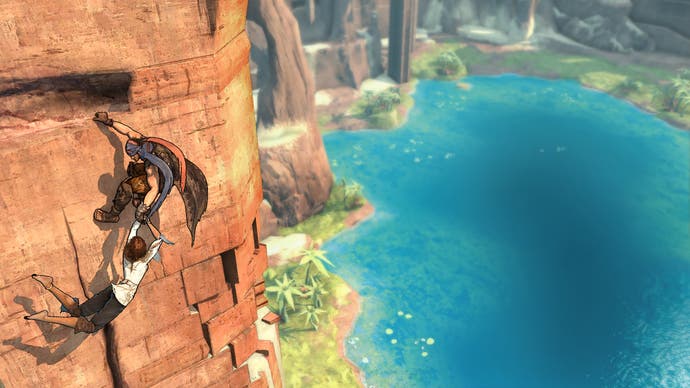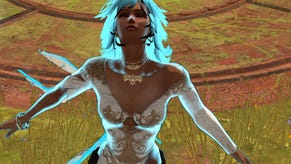Prince of Persia
A royal knockout?
The problem with trade shows is that while you get to play a lot of games, you don't get to play any of them for long. When it comes to simpler, more familiar titles like LocoRoco 2, this doesn't matter so much. In the case of games like Hula Wii, it's a mercy. But it's a real issue as far as the new Prince of Persia is concerned. It's less familiar than you might think and by no means simple.
So we discovered at this year's Tokyo Game Show, where we played through a half-hour demo led by producer Ben Mattes. After the time was up, we had more questions than answers.
They began to emerge during the game's opening sequence. The visuals are just as pretty as you've seen in the screenshots, but it's ruined the moment the characters open their mouths. Our hero may be wearing a load of scarves but he sounds no more Persian than Jamie Oliver, and would be better off calling himself the Prince of Canadia. His new sidekick, Elika, also sounds like she's from Montreal, though she's dressed like a mail-order bride from Minsk.
There's a bit of business with the prince and Elika and a donkey. The donkey is the only one capable of getting through a dialogue exchange without making a wisecrack. The prince says things like "Whoa". At one point he falls down a chasm, and you think he's going to say, "Oh, crap!", but perhaps that was too edgy, because it turns into, "Oh, cra-aaaaah!" On another occasion there's an allegedly comedic reference to 'Farah', which according to Mattes is "the extent of the connection with the previous Prince of Persia games". Fans may feel that's a shame, and wish for a (sands of) time when the prince was quieter, nobler and didn't say "aboot".

But perhaps it's aboot time we all moved on. Since the new Prince of Persia was announced, Ubisoft has been frank about its intention to take the series in a new direction. From the first moment you pick up the controller, it's clear that's what's happened. Walking around is different; the prince moves more slowly, with a heavier gait. He can pull off huge jumps and impressive acrobatic moves, but the pace is slower here too.
You control the prince using a new system that we're told was designed to be simpler and more intuitive. If you want to do a wall-run, for example, you no longer need to worry about pressing a second button. Just jump at the wall and the prince will run along it automatically - either vertically or horizontally, depending on which angle you made the jump from. Then just press the jump button again to eject from the run.

A bit of confidence is required to jump at a wall and trust the prince will run along it, especially when he doesn't seem to do this the first few tries. It took a little practice to work out how to get the angle right and build up confidence, but not much. There was a problem with one particular ledge where the prince kept dropping down and hanging instead of jumping off. This is the sort of niggly issue that final testing is designed to iron out, however. For the most part we were able to make the prince run, jump, climb posts and swing off poles without much difficulty - though perhaps without quite the same fast-paced fluidity as in the Sands of Time trilogy.
But it's in combat situations where the new Prince of Persia really stands apart. You have one button for sword-slashing and another for using your gauntlet, and you can combine button presses to pull off different kinds of attacks. So it's B to throw your enemy in the air, A to jump up after him and X to slash him to the ground on Xbox 360, for example. Nothing revolutionary there, but the twist is that combat takes place at a much slower pace. It's not just slower than in previous POP titles, but slower than in the vast majority of action games. There are no prizes for fast fingerwork here, as Mattes explains.







